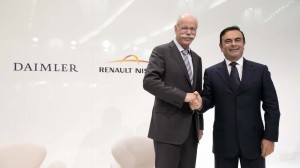
Daimler Chairman Dieter Zetsche and Renault-Nissan CEO Carlos Ghosn meet in Frankfurt to update the media on their expanding partnership.
In what has become a regular, if recent, tradition, Daimler Chairman Dieter Zetsche and Renault-Nissan Alliance CEO Carlos Ghosn came together at the Frankfurt Motor Show, sharing a stage to describe the increasing cooperation between the three automakers.
But perhaps the biggest question the two executives were expected to face was left unanswered, Zetsche and Ghosn insisting they had not locked down widely anticipated plans to jointly produce luxury cars at a new Nissan plant soon to open in Mexico.
When the French-Japanese-German partnership was unveiled in April 2010, the makers set to work on three projects largely focused on Europe. Since then, however, they have brought the count to 10, with others under discussion.
“There is no limit to the cooperation” possible, Ghosn told reporters during the hour-long session, though he did add one caveat. He called “unacceptable…anything that would lead to confusion” between the various brands.
“While our initial collaboration focused strongly on European projects, we are now focusing on synergies in all key markets”, Ghosn added. “The largest economies of scale are always global.“
The Nissan plant in Decherd, Tennessee already is preparing to launch production of new four-cylinder engines that will be used on the Mercedes-Benz assembly line in Tuscaloosa, Alabama. Nissan’s Infiniti brand will use the same engines in some of its vehicles.
(For a complete round-up of the news and previews from the Frankfurt Motor Show, Click Here.)
Meanwhile, Renault is taking the lead in the development of a new small car platform that will be used for both its Twizy model and for a new microcompact that will be sold by Daimler’s struggling Smart brand.
A project that stretches the limits of the cooperative venture involves the downsized luxury “architecture” developed by Daimler’s Mercedes brand for new models like the CLA and A-Class, as well as the compact GLA crossover debuting in Frankfurt this week. Infiniti, meanwhile, will use the same platform for a variety of its own models, including a production version of the Q30 crossover it unveiled at the Frankfurt Motor Show.
In the past, Zetsche and Ghosn have both insisted that this platform sharing isn’t a problem because they contend the Mercedes and Infiniti brands appeal to a very different sort of buyer. That position could be challenged by the Nissan luxury marque’s current expansion plans. It has traditional been targeted at upscale, Japanese-oriented buyers in the United States. But Infiniti outlined a strategy in Frankfurt to expand its appeal as well as its geographic reach.
(Click Here for a first look at the Infiniti Q30.)
One of the advantages of platform sharing is that a variety of different models could be built on the same assembly line and, as TheDetroitBureau.com first reported a year ago, the two makers have been considering the possibility of producing not only the final version of the infiniti Q30 but also the Mercedes GLA at the new Nissan plant in Aguascalientes, Mexico.
While Zetsche has repeatedly confirmed such a study is underway, he countered news reports of the last several days indicating the project had been approved.
That delay does not appear to have set back the broader atmosphere of cooperation between the three manufacturers, however.
(Click Here to find out more about the possible joint production of the Infiniti Q30 and Mercedes GLA.)
“I think from Day One, I have seen a great openness on our side,” said the Daimler Chairman, who has said his company learned a lot about partnerships through the failure of its “merger of equals” with America’s Chrysler. “We will continue to seek out new projects together that make sense for all partners and, most importantly, our customers.”
Most observers expect the plan to jointly build Infiniti and Mercedes products in Mexico eventually will go through. Even if it doesn’t, though, the partners are expected to continue seeking out new opportunities.

Exporting jobs and production is good for CEO annual bonuses but not for employees or customers of these companies – who might want to start voting with their wallets.